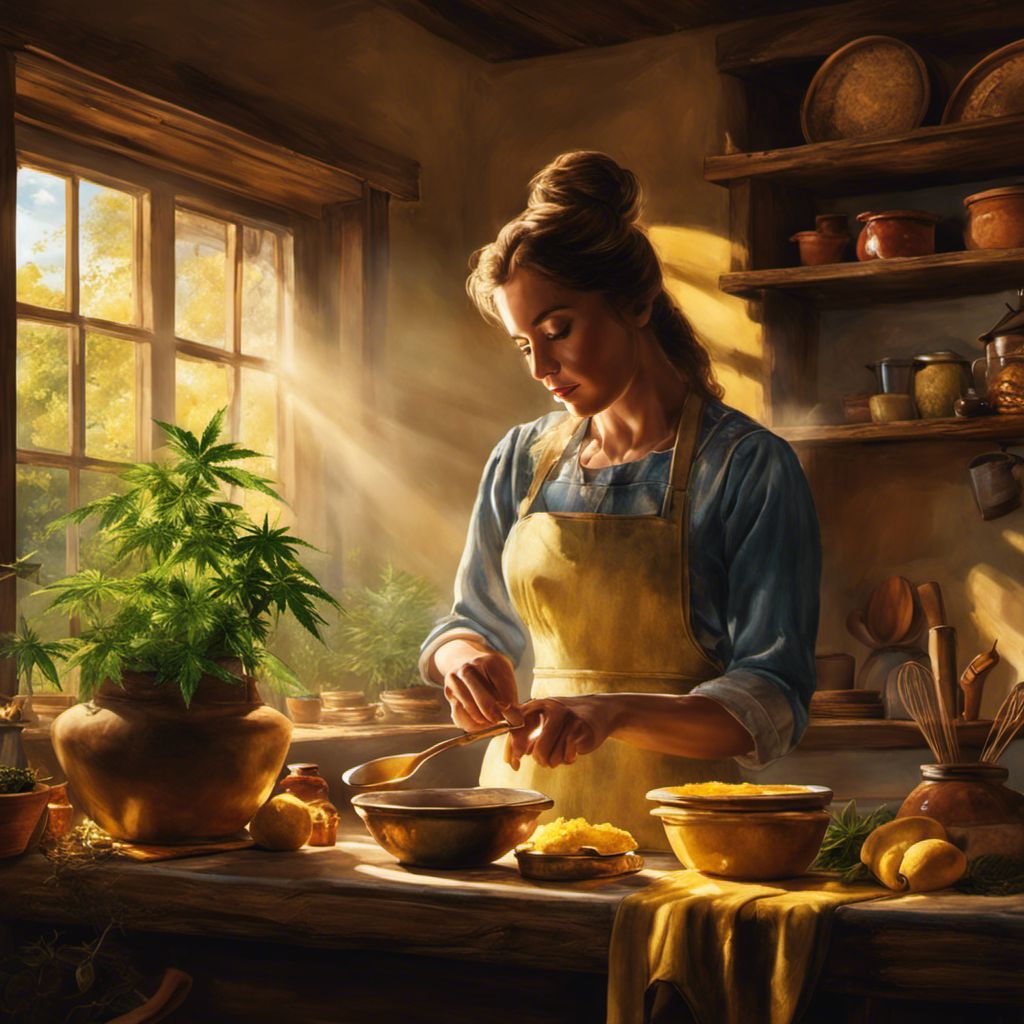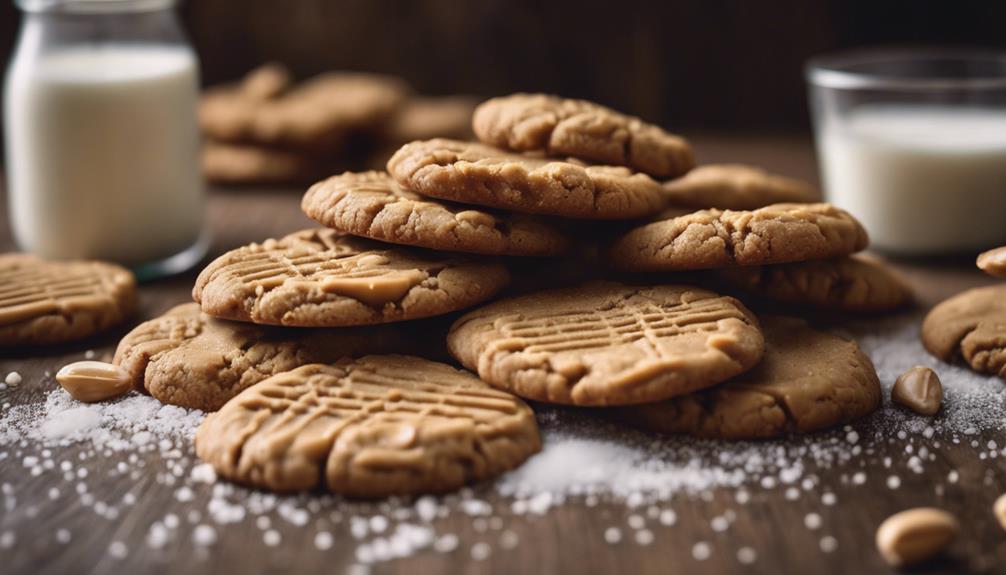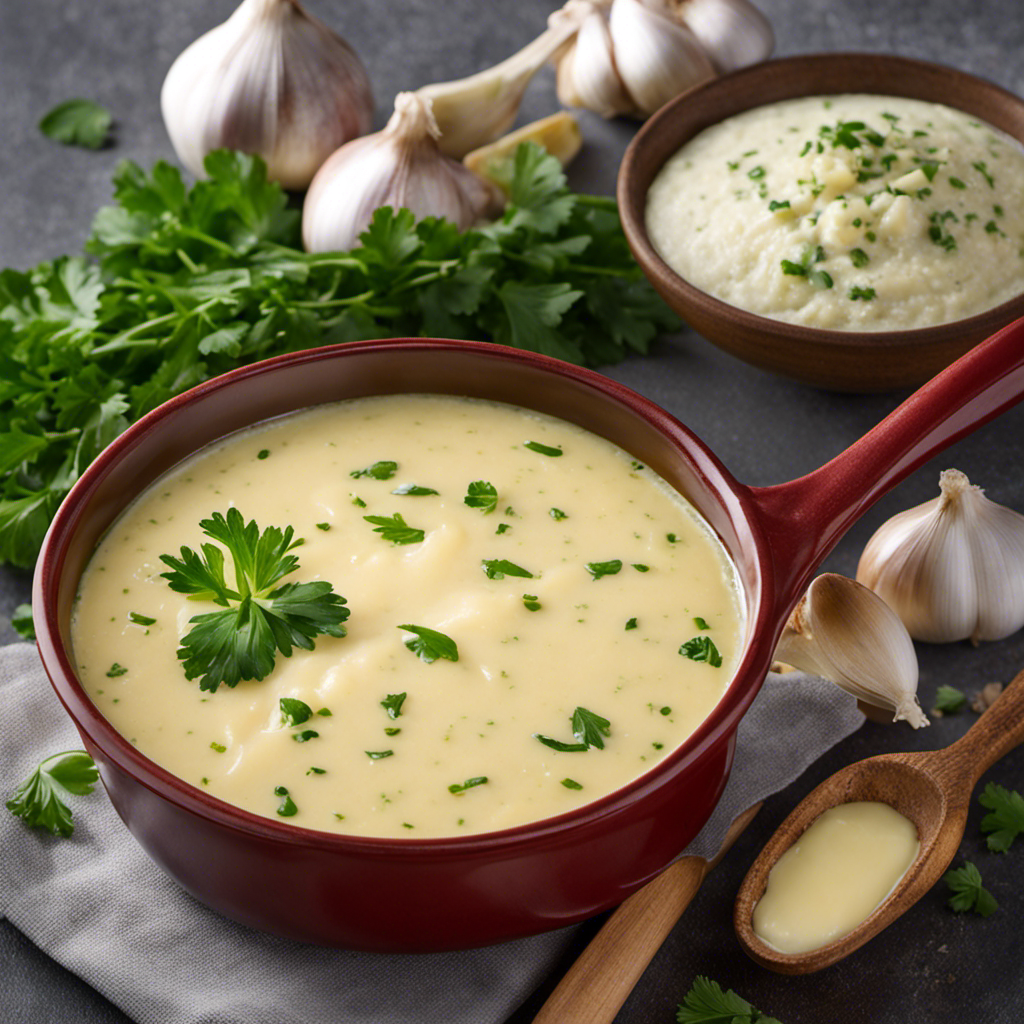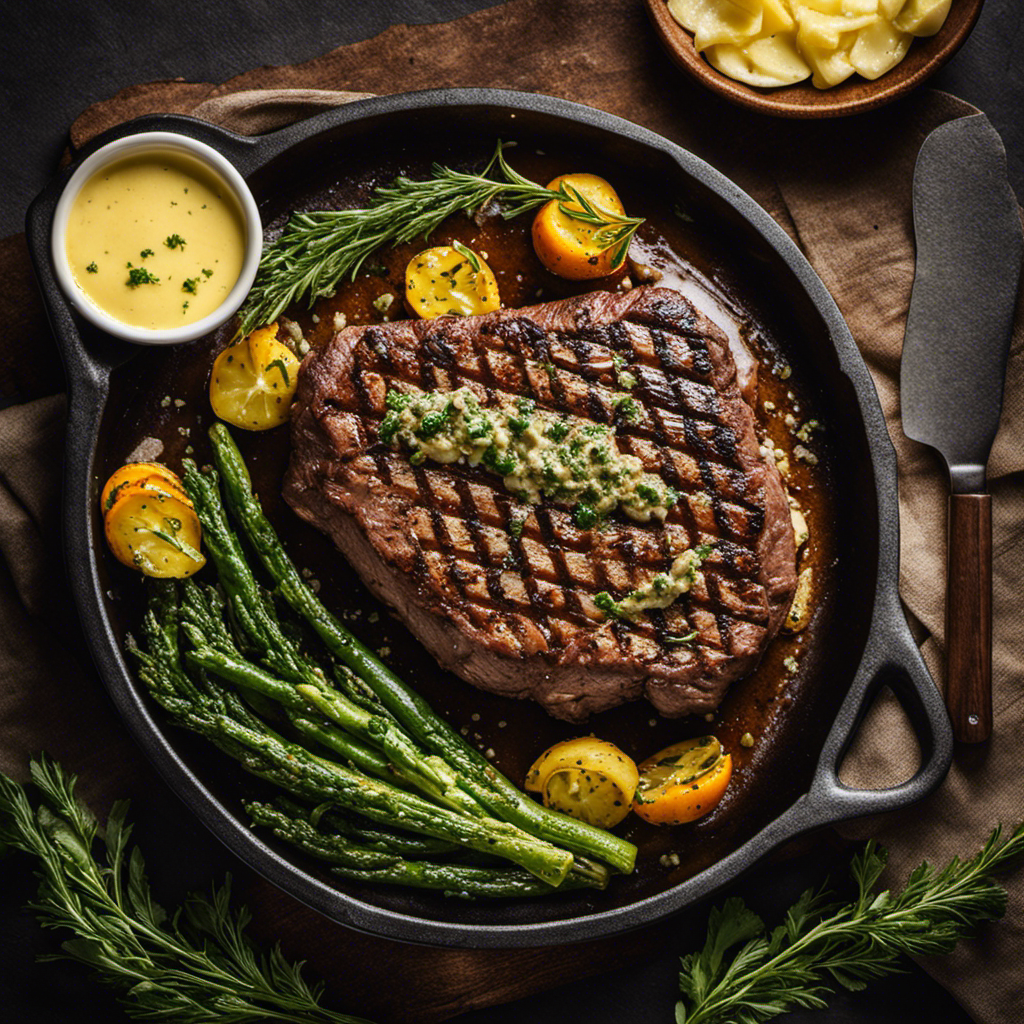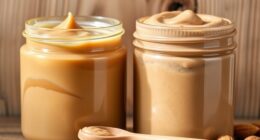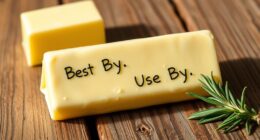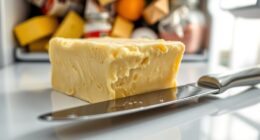Picture yourself enjoying a flawlessly prepared steak, its tender succulence elevated by the decadent and opulent taste of truffle butter.
In this article, I will guide you through the process of making your own homemade truffle butter, elevating your steak to new heights of decadence.
We will explore the art of selecting the right truffle, gathering the necessary ingredients, and infusing the butter with the essence of truffle.
Get ready to embark on a culinary adventure that will leave your taste buds craving for more.
Key Takeaways
- Consider flavor profiles when selecting truffle varieties for making truffle butter for steak.
- Essential ingredients for truffle butter include high-quality butter and fresh truffles, but substitutes like truffle oil or truffle paste can be used.
- Proper ingredient preparation, such as cleaning the truffles thoroughly and softening the butter to the right consistency, is important for the best flavor.
- When storing truffle butter, it should be kept in an airtight container in the refrigerator to maintain freshness, and it should be stored separately from strong-smelling foods to avoid cross-contamination.
Selecting the Right Truffle
To make the best truffle butter for your steak, it’s important to choose the right truffle. Consider their flavor profiles when selecting truffle varieties. There are several types available, each with its own distinctive taste. The most common varieties include black truffles, white truffles, and summer truffles.
Black truffles have a rich, earthy flavor with hints of chocolate and garlic. White truffles are known for their intense aroma and delicate taste, often described as garlicky and musky. Summer truffles, on the other hand, have a milder flavor that is both nutty and slightly sweet.
By choosing the truffle that best complements your personal preferences and the flavor of your steak, you can ensure a truly exquisite truffle butter.
Now, let’s move on to gathering the ingredients.
Gathering the Ingredients
When it comes to making truffle butter, there are a few essential ingredients that you’ll need to gather.
First and foremost, you’ll need high-quality butter, preferably unsalted.
Additionally, you’ll need fresh truffles, either black or white, depending on your preference. If you’re unable to find fresh truffles, don’t worry – there are substitutes available, such as truffle oil or truffle paste.
Lastly, proper ingredient preparation is key to achieving the best flavor. Make sure to clean the truffles thoroughly and soften the butter to the right consistency before incorporating the truffles.
Essential Ingredients for Truffle Butter
You’ll need butter, truffle oil, and finely chopped fresh truffles for your homemade truffle butter. However, if you don’t have access to fresh truffles or truffle oil, there are alternatives you can use.
Instead of fresh truffles, you can use truffle salt or truffle paste, which will still give your butter a delicious truffle flavor. Truffle oil can be substituted with olive oil infused with truffle essence or even a few drops of truffle extract. These alternatives will still provide a rich and earthy taste to your truffle butter.
As for the health benefits of truffle butter, truffles are known to be a good source of antioxidants, which help protect our bodies from damage caused by free radicals. Additionally, truffles are low in calories and fat, making truffle butter a healthier option compared to regular butter.
Substitutes for Unavailable Ingredients
If fresh truffles or truffle oil are unavailable, there are alternative ingredients you can use in your homemade truffle butter. Don’t worry, you can still achieve that rich and earthy flavor with a few creative ingredient swaps. Here are some substitutes for unavailable ingredients:
- Mushrooms: Use finely chopped mushrooms to mimic the earthy taste of truffles.
- Truffle salt: Sprinkle some truffle salt into your butter for a burst of truffle flavor.
- Truffle-infused olive oil: If truffle oil is not on hand, drizzle some truffle-infused olive oil into your butter mixture.
- Truffle paste: Add a dollop of truffle paste to your butter for an intense truffle taste.
- Truffle seasoning: Sprinkle truffle seasoning into your butter, which combines various truffle flavors.
These creative ingredient swaps will help you achieve a delicious truffle butter even when the traditional ingredients are unavailable. Get creative and enjoy the rich and luxurious taste of truffles on your steak.
Tips for Ingredient Preparation
To prepare the alternative ingredients for your truffle butter, start by finely chopping the mushrooms and sprinkling some truffle salt into your mixture. This step is crucial in ensuring that the flavors of the mushrooms and truffle salt are evenly distributed throughout the butter.
When storing your ingredients, it is important to keep the mushrooms in a cool, dry place to maintain their freshness. As for the truffle salt, make sure to store it in an airtight container to preserve its intense aroma.
When it comes to flavor pairing, mushrooms and truffle salt are a match made in heaven. The earthy, umami notes of the mushrooms perfectly complement the intense, savory flavor of the truffle salt.
Now that your alternative ingredients are prepared and stored, you are ready to move on to the next step, which is preparing the truffle butter base.
Preparing the Truffle Butter Base
Mix together softened butter, minced garlic, chopped fresh herbs, and finely grated truffle, creating a flavorful base for the truffle butter. This luxurious spread adds a rich and earthy taste to any dish, especially when paired with steak.
Here are some variations of truffle butter that you can experiment with:
- White truffle butter: Made with white truffle, this variation has a more delicate and subtle flavor.
- Black truffle butter: Made with black truffle, this variation has a stronger and more robust flavor.
- Truffle and mushroom butter: Incorporating sautéed mushrooms into the mix adds an extra layer of earthiness.
- Truffle and Parmesan butter: The combination of truffle and Parmesan cheese creates a salty and savory profile.
- Truffle and lemon butter: Adding a squeeze of fresh lemon juice brightens up the flavors and balances the richness.
Once you’ve prepared your truffle butter, it can be used in a variety of ways. Spread it on warm crusty bread, melt a dollop on top of a juicy steak, or use it to elevate mashed potatoes or pasta dishes. The possibilities are endless!
Incorporating the Truffle Flavors
Now that we have our truffle butter base ready, it’s time to incorporate those delicious truffle flavors. This step is crucial in enhancing the steak with the irresistible taste of truffle.
To do this, I like to add finely chopped black truffles to the butter mixture. The earthy aroma and rich flavors of the truffles infuse into the butter, creating a decadent and savory combination. I find that using about two tablespoons of chopped truffles per cup of butter provides the perfect balance of flavor.
Gently fold the truffles into the butter, making sure they are evenly distributed. This step adds an extra layer of luxury to your truffle butter, taking it to a whole new level.
And now, with our truffle flavors fully incorporated, it’s time to move on to the next step of infusing the butter with truffle essence.
Infusing the Butter With Truffle Essence
After the truffle flavors have been incorporated, it’s time to infuse the butter with truffle essence. Infusing the butter is crucial to ensure that the truffle aroma and taste are evenly distributed throughout.
Here are some techniques to infuse the butter with truffle essence:
- Melt the butter gently in a saucepan over low heat.
- Add finely chopped or grated truffle to the melted butter.
- Stir the mixture continuously for about 5 minutes to allow the flavors to blend.
- Remove the saucepan from heat and let the butter cool for a few minutes.
- Strain the butter to remove any solid truffle pieces, leaving behind a smooth, fragrant truffle-infused butter.
Pairing suggestions for truffle butter include grilled steaks, roasted vegetables, mashed potatoes, or even spreading it on warm crusty bread. The rich, earthy flavor of truffles adds a luxurious touch to any dish.
Chilling and Storing the Truffle Butter
When it comes to chilling and storing truffle butter, there are a few key points to consider.
Firstly, the optimal storage temperature is crucial to maintain the butter’s quality and flavor.
Additionally, understanding the shelf life duration will ensure that you use the butter before it spoils.
Lastly, choosing the proper container is essential to protect the butter from exposure to air and potential contamination.
Let’s dive into these factors to ensure your truffle butter stays fresh and delicious.
Optimal Storage Temperature
To keep your truffle butter fresh and flavorful, store it at the optimal temperature of 35-40 degrees Fahrenheit. This temperature range ensures that the delicate truffle flavor is preserved and that the butter remains solid without freezing.
Here are some key points to remember about storing truffle butter:
-
Temperature control: Maintaining a consistent temperature helps preserve the truffle flavor and prevents the butter from melting or becoming too hard.
-
Refrigeration: Store your truffle butter in the refrigerator to keep it at the optimal temperature range.
-
Air-tight container: Use an air-tight container to prevent any odors from seeping into the butter and compromising its flavor.
-
Separate storage: Keep your truffle butter away from strong-smelling foods to avoid any cross-contamination of aromas.
-
Labeling: Properly label your truffle butter container with the date of preparation to ensure freshness and easy identification.
Shelf Life Duration
In my quest to perfect the art of making truffle butter for steak, I’ve learned that proper storage is key to preserving its shelf life and extending its freshness. After all, what’s the point of making a delicious compound butter if it goes bad before you can use it?
To help you understand the shelf life duration of truffle butter and how to extend its freshness, take a look at the table below:
| Storage Method | Shelf Life Duration |
|---|---|
| Refrigerator | 1-2 weeks |
| Freezer | 3-4 months |
| Vacuum-sealed bag | 6-8 months |
| Glass jar | 1 year or more |
| Airtight container | 1 year or more |
As you can see, the choice of storage method can greatly impact the longevity of your truffle butter. However, no matter the method, always make sure to use a proper container to keep it fresh and delicious. Now, let’s delve into the importance of choosing the right container for your truffle butter.
Proper Container Choice
To ensure the longevity of your truffle-infused spread, it’s crucial to select the right container for storage. Proper container choice plays a significant role in maintaining the freshness and flavor of your homemade truffle butter. Here are some container options and the best storage methods to consider:
-
Glass jars with airtight lids: These are ideal for preserving the aroma and taste of truffle butter.
-
Stainless steel containers: They provide excellent insulation and protect against light and air exposure.
-
Silicone molds: These allow for easy portioning and freezing of truffle butter.
-
Vacuum-sealed bags: They remove excess air, preventing oxidation and freezer burn.
-
Ceramic crocks: These provide a cool and dark environment, perfect for long-term storage.
By choosing the right container and storage method, you can ensure that your truffle butter remains fresh, aromatic, and ready to enhance your favorite steak.
Using Truffle Butter to Enhance Steak
Using truffle butter is a delicious way to enhance the flavor of your steak. Not only does it add a rich and earthy taste, but it also brings a luxurious and indulgent element to your dish.
But did you know that truffle butter can be used in other recipes as well? Its versatility makes it a great addition to pasta dishes, roasted vegetables, and even popcorn.
The health benefits of truffle butter are also worth mentioning. Truffles are known to be a good source of antioxidants, which can help protect against cell damage. Additionally, truffle butter contains healthy fats, which can support brain health and reduce inflammation.
Frequently Asked Questions
Can I Use Any Type of Truffle for Making Truffle Butter?
Yes, you can use different types of truffles for making truffle butter. While black and white truffles are commonly used, there are also alternatives like truffle oil or truffle paste that can be used to achieve a similar flavor.
What Are Some Common Ingredients Used in Truffle Butter?
When making truffle butter, common ingredients include butter, truffle oil or shaved truffles, salt, and sometimes garlic or herbs. This versatile ingredient can be used in various dishes to add a rich and earthy flavor.
How Long Does It Take to Prepare the Truffle Butter Base?
Preparing the truffle butter base doesn’t take long, usually around 10 minutes. It can be made with alternative ingredients like unsalted butter and truffle oil or fresh truffles.
Can I Use Truffle Oil Instead of Truffle Essence for Infusing the Butter?
Can I use truffle oil instead of truffle essence for infusing butter? The pros of using truffle oil are its intense flavor and availability, but the cons include the risk of overpowering the dish. Best practice is to use truffle essence for a more balanced infusion.
How Long Can I Store the Truffle Butter in the Refrigerator Before It Goes Bad?
To properly store truffle butter, it is important to refrigerate it promptly. It can be stored for up to two weeks in the refrigerator before it goes bad. As for alternatives to truffle butter for steak, you can try using truffle oil or truffle salt.
Conclusion
So there you have it, a detailed guide on how to make truffle butter for steak.
With the right truffle and a few simple ingredients, you can create a luxurious and flavorful addition to your favorite steak dishes.
The process of preparing and infusing the butter may take some time and effort, but the end result is definitely worth it.
So why not give it a try and elevate your steak to a whole new level of deliciousness?
Who can resist the decadent flavors of truffle butter?

